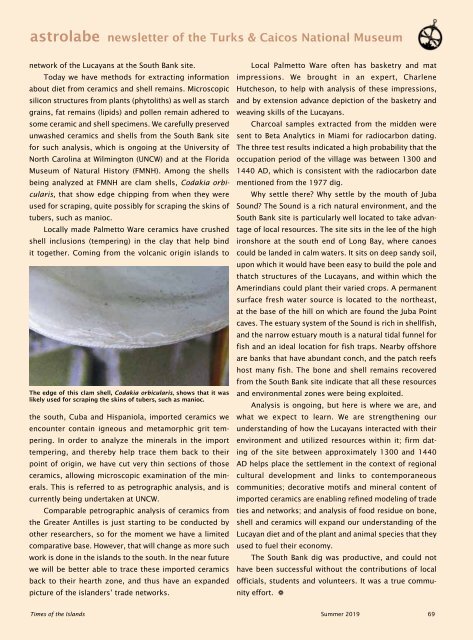Times of the Islands Summer 2019
Presents the "soul of the Turks & Caicos Islands" with in-depth features about local people, culture, history, environment, businesses, resorts, restaurants and activities.
Presents the "soul of the Turks & Caicos Islands" with in-depth features about local people, culture, history, environment, businesses, resorts, restaurants and activities.
You also want an ePaper? Increase the reach of your titles
YUMPU automatically turns print PDFs into web optimized ePapers that Google loves.
astrolabe newsletter <strong>of</strong> <strong>the</strong> Turks & Caicos National Museum<br />
network <strong>of</strong> <strong>the</strong> Lucayans at <strong>the</strong> South Bank site.<br />
Today we have methods for extracting information<br />
about diet from ceramics and shell remains. Microscopic<br />
silicon structures from plants (phytoliths) as well as starch<br />
grains, fat remains (lipids) and pollen remain adhered to<br />
some ceramic and shell specimens. We carefully preserved<br />
unwashed ceramics and shells from <strong>the</strong> South Bank site<br />
for such analysis, which is ongoing at <strong>the</strong> University <strong>of</strong><br />
North Carolina at Wilmington (UNCW) and at <strong>the</strong> Florida<br />
Museum <strong>of</strong> Natural History (FMNH). Among <strong>the</strong> shells<br />
being analyzed at FMNH are clam shells, Codakia orbicularis,<br />
that show edge chipping from when <strong>the</strong>y were<br />
used for scraping, quite possibly for scraping <strong>the</strong> skins <strong>of</strong><br />
tubers, such as manioc.<br />
Locally made Palmetto Ware ceramics have crushed<br />
shell inclusions (tempering) in <strong>the</strong> clay that help bind<br />
it toge<strong>the</strong>r. Coming from <strong>the</strong> volcanic origin islands to<br />
The edge <strong>of</strong> this clam shell, Codakia orbicularis, shows that it was<br />
likely used for scraping <strong>the</strong> skins <strong>of</strong> tubers, such as manioc.<br />
<strong>the</strong> south, Cuba and Hispaniola, imported ceramics we<br />
encounter contain igneous and metamorphic grit tempering.<br />
In order to analyze <strong>the</strong> minerals in <strong>the</strong> import<br />
tempering, and <strong>the</strong>reby help trace <strong>the</strong>m back to <strong>the</strong>ir<br />
point <strong>of</strong> origin, we have cut very thin sections <strong>of</strong> those<br />
ceramics, allowing microscopic examination <strong>of</strong> <strong>the</strong> minerals.<br />
This is referred to as petrographic analysis, and is<br />
currently being undertaken at UNCW.<br />
Comparable petrographic analysis <strong>of</strong> ceramics from<br />
<strong>the</strong> Greater Antilles is just starting to be conducted by<br />
o<strong>the</strong>r researchers, so for <strong>the</strong> moment we have a limited<br />
comparative base. However, that will change as more such<br />
work is done in <strong>the</strong> islands to <strong>the</strong> south. In <strong>the</strong> near future<br />
we will be better able to trace <strong>the</strong>se imported ceramics<br />
back to <strong>the</strong>ir hearth zone, and thus have an expanded<br />
picture <strong>of</strong> <strong>the</strong> islanders’ trade networks.<br />
Local Palmetto Ware <strong>of</strong>ten has basketry and mat<br />
impressions. We brought in an expert, Charlene<br />
Hutcheson, to help with analysis <strong>of</strong> <strong>the</strong>se impressions,<br />
and by extension advance depiction <strong>of</strong> <strong>the</strong> basketry and<br />
weaving skills <strong>of</strong> <strong>the</strong> Lucayans.<br />
Charcoal samples extracted from <strong>the</strong> midden were<br />
sent to Beta Analytics in Miami for radiocarbon dating.<br />
The three test results indicated a high probability that <strong>the</strong><br />
occupation period <strong>of</strong> <strong>the</strong> village was between 1300 and<br />
1440 AD, which is consistent with <strong>the</strong> radiocarbon date<br />
mentioned from <strong>the</strong> 1977 dig.<br />
Why settle <strong>the</strong>re? Why settle by <strong>the</strong> mouth <strong>of</strong> Juba<br />
Sound? The Sound is a rich natural environment, and <strong>the</strong><br />
South Bank site is particularly well located to take advantage<br />
<strong>of</strong> local resources. The site sits in <strong>the</strong> lee <strong>of</strong> <strong>the</strong> high<br />
ironshore at <strong>the</strong> south end <strong>of</strong> Long Bay, where canoes<br />
could be landed in calm waters. It sits on deep sandy soil,<br />
upon which it would have been easy to build <strong>the</strong> pole and<br />
thatch structures <strong>of</strong> <strong>the</strong> Lucayans, and within which <strong>the</strong><br />
Amerindians could plant <strong>the</strong>ir varied crops. A permanent<br />
surface fresh water source is located to <strong>the</strong> nor<strong>the</strong>ast,<br />
at <strong>the</strong> base <strong>of</strong> <strong>the</strong> hill on which are found <strong>the</strong> Juba Point<br />
caves. The estuary system <strong>of</strong> <strong>the</strong> Sound is rich in shellfish,<br />
and <strong>the</strong> narrow estuary mouth is a natural tidal funnel for<br />
fish and an ideal location for fish traps. Nearby <strong>of</strong>fshore<br />
are banks that have abundant conch, and <strong>the</strong> patch reefs<br />
host many fish. The bone and shell remains recovered<br />
from <strong>the</strong> South Bank site indicate that all <strong>the</strong>se resources<br />
and environmental zones were being exploited.<br />
Analysis is ongoing, but here is where we are, and<br />
what we expect to learn. We are streng<strong>the</strong>ning our<br />
understanding <strong>of</strong> how <strong>the</strong> Lucayans interacted with <strong>the</strong>ir<br />
environment and utilized resources within it; firm dating<br />
<strong>of</strong> <strong>the</strong> site between approximately 1300 and 1440<br />
AD helps place <strong>the</strong> settlement in <strong>the</strong> context <strong>of</strong> regional<br />
cultural development and links to contemporaneous<br />
communities; decorative motifs and mineral content <strong>of</strong><br />
imported ceramics are enabling refined modeling <strong>of</strong> trade<br />
ties and networks; and analysis <strong>of</strong> food residue on bone,<br />
shell and ceramics will expand our understanding <strong>of</strong> <strong>the</strong><br />
Lucayan diet and <strong>of</strong> <strong>the</strong> plant and animal species that <strong>the</strong>y<br />
used to fuel <strong>the</strong>ir economy.<br />
The South Bank dig was productive, and could not<br />
have been successful without <strong>the</strong> contributions <strong>of</strong> local<br />
<strong>of</strong>ficials, students and volunteers. It was a true community<br />
effort. a<br />
<strong>Times</strong> <strong>of</strong> <strong>the</strong> <strong>Islands</strong> <strong>Summer</strong> <strong>2019</strong> 69

















